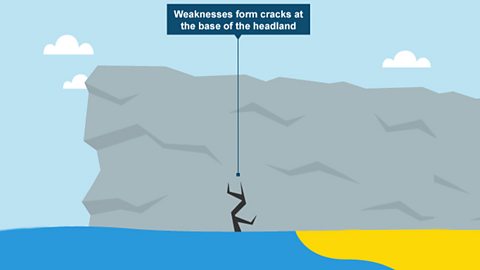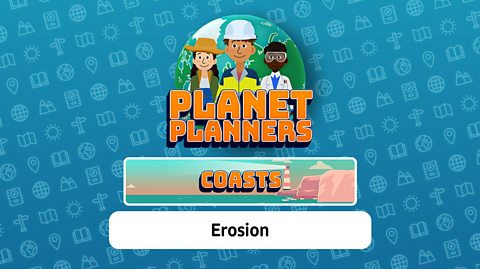What do you know?
How does wind affect coastlines?
Wind causes waves to be produced in the water. These can cause erosion of the coast. Wind can also cause material to be transported, for example by longshore drift, which is where sediment moves along the coast in a zig-zag pattern in the direction of the prevailing wind before being deposited.
Key points
- Coastlines are shaped by a number of processes such as erosionWhere rocks are worn away, in this case by the action of waves., transportationWhen sediment (small fragments of rocks and soil) is moved by waves. and depositionWhen water, that is carrying sediment (small fragments of rocks and soil), loses its energy it drops the material it is carrying. This often builds up to form a beach..
- These processes can lead to a number of different types of landforms such as caves, arches, stacks and stumps.
- Different types of landforms are caused due to several influences such as the geology of the coast.
Game - Erosion
Play a Planet Planners mission to help locals, tourists, plants and animals deal with erosion.
You can also play the full game
Landforms activity
Learn more about how coastlines are formed with this activity.
Coastal processes
Video: Coastal processes and landforms
Learn about coastal processes and landforms
Coastal processes and landforms
Upbeat music
Hi I'm Bella, and I live here on the Jurassic Coast in Dorset. Like coastlines around the world it is made up of different landforms.
Coastal landforms are created through processes such as erosion and deposition. Erosion happens when waves wear away the land. Different types of erosion include hydraulic action where the force of the wave traps air into the rock and breaks it apart. There is also abrasion which is the action of pebbles grinding against the rock surface like sandpaper. And attrition where rocks carried by the sea are knocked together and broken down into smaller and smoother pieces. These type of erosion create landforms such as headlands and bays, arches, caves, stacks and stumps.
Another process that creates coastal landforms is deposition. Deposition is where the waves slow down and they drop any rocks or pebbles they are carrying. Deposition can form beaches like this one, and sand dunes, or bars and spits.
It takes thousands and thousands of years for these processes to shape the land. And they make it a beautiful place to live.
Music continues.
The landscapeThe visible features of an area of land that can be viewed at one time from one place. of a coastal region is formed as a result of various processes:
- Rocks are eroded.
- Then, the sediment that comes off is transported.
- Finally, the sediment is deposited elsewhere.
1. Erosion
Erosion is when the rocks are worn away, in this case by the action of waves. There are several different processes of erosion:
| Hydraulic action/power | When waves crash against a cliff, they force air into cracks in the rock. The force of this trapped air causes the rock to weaken and eventually break. |
| Abrasion/corrasion | This is where sedimentEroded material or soil carried by the water. being carried by the water wears away the surface, almost like sandpaper. |
| Solution | Chemicals in the water dissolve certain types of rock such as limestone. However, there is some debate about how much coastal erosion this causes. |
| Attrition | Rocks crashing into each other result in them becoming smoother and more rounded. |
2. Transportation
Sediment in the water will be transported. This happens in four different ways:
- suspension - lighter material floats within the water
- traction - larger rocks roll along the sea bed
- solution - some material, such as chalk, gets dissolved into the water
- saltation - smaller rocks, if they are too heavy to be suspended, hop along the sea bed
3. Deposition
When waves carrying sediment reach the shore, they will deposit it in areas where they lose energy - often in sheltered areas such as bays. This can lead to the formation of beaches. Sometimes the waves will continue to move sediment along the beach. The direction this is moved in will depend on the prevailing windWind that blows from a single direction over a specific area.. If the wind is coming in at an angle, then the waves will also move up and down the beach at an angle. This causes the sediment to be moved in a zig-zag pattern. This is called longshore driftThe movement of sediment along the beach in a zigzag pattern in the direction of the prevailing wind..
Question
Name the four processes of erosion.
The four processes of erosion are:
- hydraulic action/power
- abrasion /corrasion
- solution
- attrition
Quiz: Coastal processes
Coastal landforms
Geology
The geologyRelating to the study of rocks and their location beneath the surface of the Earth. of a coastline influences the landforms we see there. Some rocks are harder than others and so are more resistant to erosion. For example, rocks such as granite are hard and erode much more slowly than softer rocks, such as boulder clay or shale.
Examples of coastal landforms
Question
If a spit connects an island to the mainland (a headland), what landform is formed?
If a spit connects an island to the mainland (a headland), a tombolo is formed.
Quiz: Coastal landforms
Formations
How a stump is formed

Image caption, Cracks at the base of the headland become exposed through hydraulic action/power, which pressurises air, forcing the crack to widen.
Image caption, Over time, the cracks widen and further processes of abrasion and hydraulic action/power will deepen cracks and form caves.
Image caption, If a cave forms on both sides of the headland this may break through, forming an arch, such as Durdle Door, a limestone arch in Dorset.
Image caption, Over time, the arch becomes unstable and the roof collapses under its own weight to form a tall rock stack. A good example is Old Harry along the Dorset coast.
Image caption, The stack is further eroded at its base. Eventually the exposed stack will collapse to form a stump.
1 of 5
Question
If the roof of an arch collapses, what landform is formed?
When the roof of an arch collapses a sea stack is formed.
How a spit is formed
Quiz: Formation of a spit
Play the Planet Planners game! gamePlay the Planet Planners game!
Make decisions for the planet in this KS3 geography game.

More on Coasts
Find out more by working through a topic
- count2 of 2

